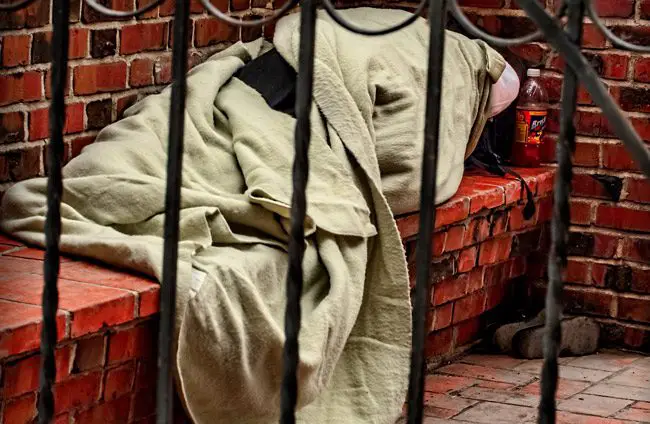
Just a few blocks from the U.S. Capitol sprawls the Federal City Shelter, the nation’s largest homeless shelter, a behemoth of beige concrete extending across an entire city block.
Outside the shelter one recent morning, James Jeffery, a grizzled 69-year-old who’s been homeless off and on for a decade, stands, philosophizing. He moved to the city a few months ago, and he’s been bothered by something ever since.
“Why are all these shelters in D.C. black more than anything?”
Then he answered his own question. “The system’s failing,” said Jeffery, who is African-American. “And this is D.C., the beacon of the world. If it’s happening here, what do you think is happening in the rest of the country?”
Jeffery’s comments reflect the challenges cities and counties face in tackling racial disparities among the homeless. People of color are disproportionately represented among the homeless, with blacks and Native Americans experiencing the highest rates among those groups.
Poverty alone doesn’t account for the stark inequities, researchers say, because the number of black and Native people who are homeless exceeds their proportion of people living in deep poverty.
Those disparities, researchers say, are the result of centuries of discrimination in housing, criminal justice, child welfare and education. What’s new, though, is that cities and counties are beginning to take a hard look at how entrenched policy has served to perpetuate homelessness in black and brown communities.
Taking the first step means identifying just how bad the problem is, said Jeff Olivet, a senior advisor for the Center for Social Innovation, a Needham, Massachusetts-based research nonprofit that focuses on homelessness. “Homelessness was an issue that wasn’t even remotely tied to race,” Olivet said. “We were just trying to end homelessness.”
“But unless you diagnose the problem correctly,” he said, “you can’t solve it.”
African-Americans make up 13 percent of the general population. Twenty-one percent of people living in poverty in the United States are black, according to census data.
But African-Americans account for 40 percent of people experiencing homelessness — and half of homeless families with children, according to the 2018 Annual Homeless Assessment Report (AHAR), produced by the U.S. Department of Housing and Urban Development. American Indians also are overrepresented in the homeless population.
Latinos make up a share of the homeless population (22 percent) that is slightly higher than their share of the general population (18 percent). Based on their percentage of the total population, the number of homeless whites and Asians is disproportionately low.
Increasingly, local governments are exploring ways to address the racial disparities. Los Angeles in February announced an initiative to tackle rising black homelessness after voters approved a local tax hike to build housing.
King County officials in the Seattle area have created a data system to track the homeless population and understand its racial composition. And in 2017, city officials awarded $3.2 million to five Native-led nonprofits for homelessness programs.
“People are all over the issue now,” said Steve Berg, vice president for programs and policy at the National Alliance to End Homelessness, a Washington, D.C.-based research and advocacy group. “Localities are saying, ‘What are we trying to do about this?’”
The federal government is getting involved, too: In December, HUD released a race and ethnicity data tool to help states and localities assess the conditions creating racial disparities among the homeless. And as part of its grant process, HUD now awards extra points to applicants who can demonstrate how they are addressing disparities.
The idea is to use incentives to encourage local communities to tackle obstacles people of color face, said HUD spokesman Brian Sullivan.
“Nobody likes these disparities,” Sullivan said.
“Pileup of Inequalities”
David Hewitt, director of the Hennepin County Office to End Homelessness in Minneapolis, is a native of England, and has worked in homelessness programs throughout the United Kingdom. But when he moved to the United States several years ago, Hewitt said, he was shocked.
“Racial disparities exist pretty much everywhere you go,” he said. “But here, it was striking.” In every shelter, every food bank, every drop-in center for the homeless, he said, the overwhelming majority of people being served were black and brown.
![]() People of color are more likely to get pushed into homelessness because they are more likely to have a criminal record, which makes it tough to find housing or a job. Or they have a past eviction. Or they have money to pay the rent, but can’t afford the security deposit to move into a new place. Perhaps the landlord doesn’t accept housing vouchers.
People of color are more likely to get pushed into homelessness because they are more likely to have a criminal record, which makes it tough to find housing or a job. Or they have a past eviction. Or they have money to pay the rent, but can’t afford the security deposit to move into a new place. Perhaps the landlord doesn’t accept housing vouchers.
For example, in the Seattle area, black residents are more likely to have an eviction listed on their credit report — even if they weren’t evicted, but moved out without giving advance notice, said Maya Manus of the Urban League of Metropolitan Seattle, which for the past three years has been working to address racial disparities among the homeless.
Earlier this month, the Washington state House of Representatives passed a bill overhauling the state’s eviction laws, which critics accuse of being “racist and retrograde.” (The bill was scheduled for a Senate hearing this week.) Some people have been evicted for owing a month or less in rent, even as low as $49, according to the Seattle Women’s Commission and the King County Bar Association’s Housing Justice Project. Evictions are one of the leading causes of homelessness around the country.
For homeless people of color, “it’s a pileup of inequities,” Hewitt said.
White communities have had a much longer time to build and pass along generational wealth, which serves as a buffer to homelessness, said Olivet of the Center for Social Innovation. White families living near the poverty line have about $18,000 in wealth, while similarly strapped black families have a median wealth near zero, according to a 2018 Duke University report.
“Folks of color are living so close to the edge, it doesn’t take much to slip into homelessness,” Olivet said.
To-Do List
Last year, the Center for Social Innovation offered a to-do list for cities tackling race and homelessness.
Among its recommendations: Enact and enforce fair housing laws; regulate evictions and introduce legislation to prevent mass evictions; re-introduce rent control in large urban markets; limit the scope of background checks for ex-offenders and expand eligibility for housing vouchers.
The outline was included in a 2018 report studying six communities — Atlanta; Columbus, Ohio; Dallas; San Francisco; Syracuse, New York; and Pierce County, Washington — that found two-thirds of people experiencing homelessness were black.
The report is part of an initiative called Supporting Partnerships for Anti-Racist Communities (SPARC) that uses data and analysis to help communities develop policies to eliminate racial inequities in homelessness. (Hennepin County in Minneapolis joined the project in December.)
The report also found that homelessness among American Indian/Alaskan Natives was three to eight times higher than their proportion of the general population.
Last month, Seattle, which has some of the highest rates of homelessness in the country, was hit with a series of rare snowstorms, shutting down the city. Homeless advocates scrambled to get the unsheltered out of the cold. But of the nearly thousand or so American Indians living in tent cities, most would not be moved.
“We were begging people to go into shelter,” said Colleen Echohawk, executive director of Chief Seattle Club, a nonprofit that caters to the city’s Native population, who are seven times more likely to be homeless than whites.
Most don’t trust the local government. And even when homeless Natives are assigned permanent housing — no easy feat in a city of ever-escalating rents — 84 percent don’t take advantage of it, Echohawk said.
“There’s a lot of fear,” she said.
To counter that fear, the Chief Seattle Club is building housing tailored for Native people who’ve been homeless. The development will open in 2021.
And in the Twin Cities, Hennepin County officials partnered in October with American Indian leaders to create housing for Native people who had been living in a dangerous encampment located next to a highway. In less than a month, they were able to find a building and create 16 housing units, according to Hewitt.
In Hennepin County, American Indians are more likely to be sleeping rough in outdoor encampments, while the black homeless population is more likely to be found living in shelters.
But in Los Angeles, a study by the Homeless Services Authority found that nearly 70 percent of the black homeless population live outside. Among the report’s recommendations: Establish a county-wide initiative to push for racial equity in county social services, including recruiting and hiring African-Americans who have been homeless in the past.
“I’ve met a number of people that were homeless and wanted an opportunity to thrive,” said Jacqueline Waggoner, a commissioner on the authority and chairwoman of the city’s committee on black homelessness. “But the door wasn’t cracked for them to get in.”
–Teresa Wiltz, Stateline




























Mary Fusco says
What a lot of horse poo this is. Get 2 or even 3 jobs. Stop whining and blaming society. When my kids were in college, I worked 2 jobs for 12 + hours a day for 10 years. My husband worked every hour of overtime that he could get. My kids went to school full time and worked almost full time. If you want something bad enough, you will work for it. Enough is enough of this pity party.
Curious says
So does that mean the homeless in DC are black and in Palm Coast they’re white. So I have a question? Where are the black homeless in PC, are there any. Or is there another camp somewhere. Just curious.
blacks says
blacks are also only roughly 15 percent of this countries mixed races and account for nearly 40 percent of the people in jails….
mark101 says
Interesting, all the national databases on homeless, the NHIP and the US Council on Homeless, I found NONE note homeless by race expect the database noted in this article. But the author is misleading. If you look at the data in most cases White’s are more impacted by homeless. The areas where blacks are noted at times higher is homeless with children. https://www.hudexchange.info/resources/documents/2018-AHAR-Part-1.pdf But it really doesn’t mater about race with homeless,all homeless is a tragedy regardless of race.
What is really bothersome is the veterans that are homeless. Whites: 21,825, Blacks: 12.296. That is the a real tragedy.
oldtimer says
The interesting part of this story is when offered a place to go ,most refused, same as here in palm coast so is that societys fault or the homeless who refuse help?
The Realist says
Hogwash, Why are all the people homeless in the neighborhoods around DC? Because they are black neighborhoods. Anyone of any other race that was homeless would probably be badly beaten or killed by these +victims of society”. I know someone who was in a DC neighborhood that walked into a store in a black neighborhood looking for directions. The first thing the black clerk said was boy you better get out of here, do you know where you are? (he is Caucasian by the way). Can you imagine the media coverage if the roles in that conversation were reversed and occurred in a major US city? Its time for people AND the media to start looking at person for their character and deeds instead of by their race. We would be a better nation for it.
As far as the so called homeless in Palm Coast…they are migrants not homeless…they migrate to where the money is. They flourish in areas where governments are too afraid to challenge them for fear of legal challenges.
Create ordinances that prohibit motorists from handing money or anything else out at intersections to anyone be it pan handlers or charity drive collectors, Create this ordinance in the name of public safety because of the traffic hazards that occur because of this practice. After a few weeks of handing out citations to offenders the word will get out and the migrants will move on to the next green pasture. The ACLU and any other money chasing legal group will be powerless against this strategy.
Dave says
Could you imagine how impossible it would be to be a Black homeless person in Palm Coast!? They would profile and arrest you in a heart beat. The criminal justice system is completely broken. Courts dont work and police sometimes lie. Not everyone can just go out and get hired at one job let alone 3 ,so it’s obvious there alot of white privileged people who just simply can not understand these facts.
Bill says
NONE are more bigoted then those who look at everyone by their skin color over being a individual. That being said is Dc mostly black? Its some 49% black and thats the majority of the racial make up of DC so it no wonder most would be black.
Alonzo Hudson says
Dave I agree with what you say. I think Bill is a white guy. Being Black and homeless is a bad situation. Being White and homeless not too bad. The cops will bother a Black guy before they bother s White guy. Just saying.